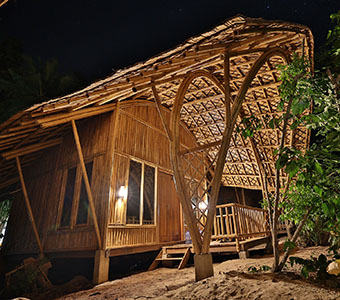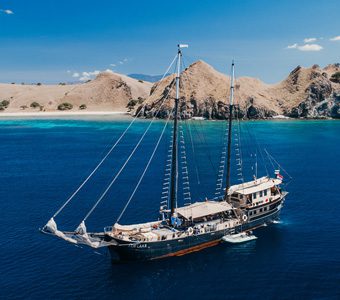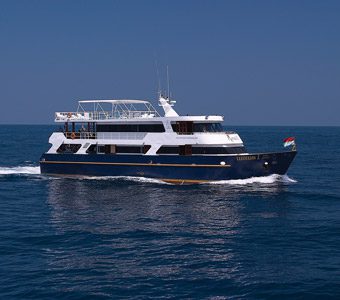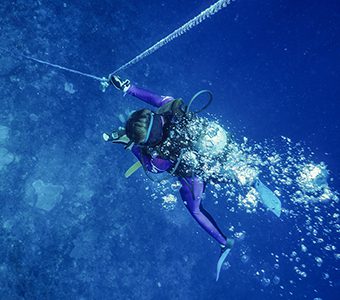So where to next? If you’ve already dived your bucket list dive destinations, where can you dive next? New and amazing dive destinations are emerging all the time – and diving them all is not going to break the bank! We take a look at what’s hot right now.
Whale sharks of Saleh Bay, Sumbawa
Whale shark encounters in Teluk Saleh (Saleh Bay) is a new tourism experience developed recently in conjunction with conservation groups. It is the second largest concentration of whale sharks after Cenderawasih Bay – around 110 whale sharks have been recorded.
Where is it? Halfway between Bali and Komodo, best reached by liveaboard.
Whale sharks come under the bagans, traditional Indonesian fishing platforms, to suck on the fishermen’s nets. They remain just below the surface, allowing interactions both while snorkeling and scuba diving. For divers, the immersion is in shallow waters, which allows for particularly long underwater observation of these sea giants. It is not uncommon for some dives to last around 2 hours or even longer.
The excursions are carefully organized to minimize impact on the animals while maximizing observation opportunities. The whale sharks of Teluk Saleh are accustomed to human presence, allowing for respectful and safe interactions. These encounters offer not only a chance to marvel at nature’s beauty but also to realize the necessity of protecting these vulnerable creatures. The Indonesian government, in collaboration with the Institut Français and Konservasi Indonesia, is working to create a Marine Protected Area (MPA) to preserve this unique ecosystem and foster a sustainable economy for local communities. This project aims to protect whale sharks while supporting economic development through responsible tourism.
Liveaboard itineraries often depart and return to Bali, with some starting and or ending in Labuan Bajo, and most include Komodo National Park
Where to Stay:
Here are a few liveaboards that have added Saleh Bay to their itineraries:
- Adelaar
- Mermaid I and Mermaid II
- Ambai & Seahorse
Suitable for divers and snorkelers.
Halmahera – the “New Raja Ampat”
So-called “New Raja Ampat” for its vibrant, pristine coral reefs and marine biodiversity – here you’ll find everything from ghost pipefish to pygmy blue whales.
Where is it? Halmahera is in the northern Moluccu Islands, halfway between North Sulawesi and Raja Ampat. Best way to get there is via daily flights to Manado.
This emerging destination was first surveyed for diving in 2021, and since then, four high quality resorts have opened. Each boasts around 40 dive sites including impressive house reefs with both macro and reef dives possible, as well as pelagic action. As this region lies far from the beaten paths of Indonesia it offers a chance to discover yet unknown dive sites, with each resort providing responsible custodianship to ensure a sustainable future for this new dive destination.
From most resorts it is just a 2-minute boat ride to the outer edge of the reef where the sandy plateaus slowly descend. There you take a break on 18m for a while and watch the sharks effortlessly gliding around you in the current. To end your dive, you will follow the reefs looking for macro and schools of sweetlips or mackerels. The whole region is famous for its pristine hard and soft corals.
On day trips you can discover dive sites on the mainland of Halmahera in the Tobelo Area where the underwater volcano and a lot of muck diving is located.
At each resort, divers have access to over 40 dive sites, at least one boasting almost a kilometre of house reef.
Where to Stay:
Resorts are situated on Proco and Kusu Islands in the south, and Morotai Island in the far north.
It has also recently been added to a number of liveaboard itineraries, including Tambora, Emperor Raja Laut and Ambai and Damai I.
Mikomoto and Izu – Hammerheads and Shark Scramble
Not far from Tokyo, the main attraction for divers on the Izu Peninsula is Mikomoto – Hammer time! While the hammerheads are there year-round, June to October is the best time to visit, when the sea conditions are calmer.
Nearby Chiba is famous for banded hound sharks and the exciting “Shark Scramble” dive.
We recommend a Shark Dive Safari, with an English-speaking dive guide. Here’s a sample itinerary:
The Shark Path
- This guided tour starts in Shimoda, with two dive days to Mikomoto Island to see the migrating Hammerheads who travel past the region nearly 10 months out of the year.
- Then head north along the Izu coast that afternoon to Atami, the famous onsen weekend getaway town at the entrance to Izu, where we will stay for the night.
- The next morning, dive the local shipwreck, the Asahi Maru, which is covered with soft and hard corals, and more life than you can count,
- Before travelling over to Tateyama in Chiba, to dive the world-famous “Shark Scramble” at Bommie for two days, where you’ll be surrounded by 300+ (or more) sharks, amongst other fish and rays, for a truly unforgettable diving experience.
The Izu Peninsula is in Shizuoka Province, roughly 2.5 hours from Tokyo. In fact, on the Tokaido Shinkansen route, Shizuoka province is roughly halfway between Tokyo and Kyoto – so you could easily add on cultural trips at either end of your shark-filled dive safari on the Izu Peninsula. Shizuoka is probably most famous for Mt Fuji, so many dive safari packages include a trek up Mt Fuji (prior to diving of course!) Contact us for more information.






